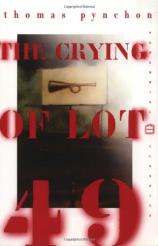Reading Group Guide
Discussion Questions
The Crying of Lot 49

1. Oedipa's search for The Tristero takes her through several labyrinths--the search itself, several buildings, night-time San Francisco, the Los Angeles freeway system. To what extent are we aware of the layout and purpose of each labyrinth? Is Oedipa's progress through each determined by her own choices? What does she discover in each?
2. How may we interpret Oedipa's endeavors as an attempt to impose order on a chaotic universe? What potential world-ordering systems and ideologies, including Inverarity's estate, must she contend with in the course of her quest? What potential systems and ideologies would she contend with today?
3. What does Oedipa learn about The Tristero through her own observations, and what through her own and others' conjecture? What conclusions does she draw? What do you think The Tristero represents? What are the implications of the acronym, W.A.S.T.E.?
4. Why does Pynchon leave Oedipa's quest unresolved? What more might she learn at the crying of lot 49?
5. What does Pierce Inverarity--with all his voices and all his possessions (while alive)--come to represent?
6.What societal outcasts, derelicts, and renegades appear in the novel, and to what purpose? What are the conditions of their lives? Do you think Pynchon would present the same examples in the same way today?
7. How are the Nefastis Machine and what it represents related to the "two distinct kinds" of entropy--the entropy posited by the Second Law of Thermodynamics (the inevitable deterioration of any system to a state of disorder and zero energy or meaning) and that of information systems (a tendency to discard excess meanings and approach certainty and predictability)? How, in turn, are the two kinds of entropy related to Oedipa's search?
8. What conclusions can we draw from Pynchon's exploration of the various technologies in American culture--television, radio, the telephone, electronics, the automobile, and others? What impact do these technologies have on the lives of Oedipa and others?
9. Pynchon writes that "Oedipa had believed, long before leaving Kinneret, in some principle of the sea as redemption for Southern California." Does she maintain that belief? Does she find other principles or sources of belief in redemption? What religious images and concepts does Pynchon present, and to what purpose?
10.After speaking with Driblette's mother and with the neo-fascist ""Winner" Tremaine, the troubled Oedipa thinks, "This is America, you live in it, you let it happen." What are the implications of that thought?
The Crying of Lot 49
- Publication Date: April 1, 1999
- Paperback: 160 pages
- Publisher: Harper Perennial Modern Classics
- ISBN-10: 0060931671
- ISBN-13: 9780060931674








